Due to its immense size, Russia shares land borders with 14 countries which include: Finland, Norway, Estonia, Latvia, Lithuania, Poland, Belarus, Ukraine, Georgia, Azerbaijan, Kazakhstan, Mongolia, China, and North Korea.
Maintaining strong relationships with neighboring states has long been a geopolitical priority for Russia. Neighboring nations help shape Russia’s foreign policy, trade, and regional dynamics. From historic alliances to present-day disputes, the relationships between Russia and its bordering countries are a tapestry of complexities. In this article, we explore the 14 nations that border Russia, delving into the shared histories and current dynamics that characterize each relationship.
1. Finland

Finland is one of 14 countries that borders Russia.
©Pawel Radomski/Shutterstock.com
Russia and Finland share an 832-mile-long border. It runs approximately north to south, mostly through taiga forests and sparsely populated rural areas. The border does not follow any natural landmarks, such as rivers. It is also an external border of the European Union and NATO.
The relationship between the two countries has generally been peaceful, with active economic and cultural exchanges. However, historical tensions stemming from territorial disputes have occasionally strained the relationship.
2. Norway

Norway shares both a land border and a maritime border with Russia.
©Tatohra/Shutterstock.com
The border between Norway and Russia consists of both a land border and a maritime border. The land border spans approximately 121.6 miles, running through taiga forests and rural areas, following the Pasvikelva and Jakobselva rivers. In addition, there is a maritime border in the Varangerfjord, covering around 14.4 miles. Both countries also have exclusive economic zones in the Barents Sea and the Arctic Ocean, which are considered part of the border.
The relationship between the two countries has been relatively stable, with cooperation in areas such as cross-border trade, fishing, and environmental protection. However, disagreements over issues like military activities in the Arctic have caused occasional tensions.
3. Estonia

Since Estonia gained independence, the relationship between the two countries is complex.
©Juan_Hernandez/Shutterstock.com
The Estonia-Russia border spans about 182 miles. The border between Estonia and Russia is located in the southeastern part of Estonia. It is likely that the border runs through rural areas and may include border crossing points such as Luhamaa. The border between Estonia and Russia has been a subject of historical and political significance, including territorial disputes and security concerns.
Since Estonia gained independence from the Soviet Union, the relationship between the two countries has been complex. Tensions have arisen due to historical disputes, cybersecurity concerns, and divergent political and economic ideologies.
4. Latvia

The border between Latvia and Russia has been a subject of historical and political significance.
©iStock.com/Anastasiia_Guseva
The border between Latvia and Russia is approximately 206 miles long. It runs through rural areas and includes border crossing points. In March 2007, Latvia and Russia signed a border treaty, which included the permanent demarcation of the boundary between the two countries. The border between Latvia and Russia has been a subject of historical and political significance, including territorial disputes and the implementation of strict Schengen border rules.
The relationship between the two countries has been influenced by historical ties and cultural exchanges. However, security concerns, ethnic tensions, and differing political alignments have occasionally strained their relationship.
5. Lithuania

The border between Lithuania and Russia runs through rural areas.
©Ja Crispy/Shutterstock.com
The Lithuania-Russia border stretches for approximately 141 miles. The border between Lithuania and Russia is located in the northeastern part of Lithuania. It runs through rural areas and may include border crossing points such as Kybartai and Panemunė. The border between Lithuania and Russia has historical and political significance, including issues related to territorial disputes and security concerns.
Historical and political factors have shaped the relationship between the two countries. Tensions have arisen due to issues such as energy dependence, security concerns, and historical disputes.
6. Poland
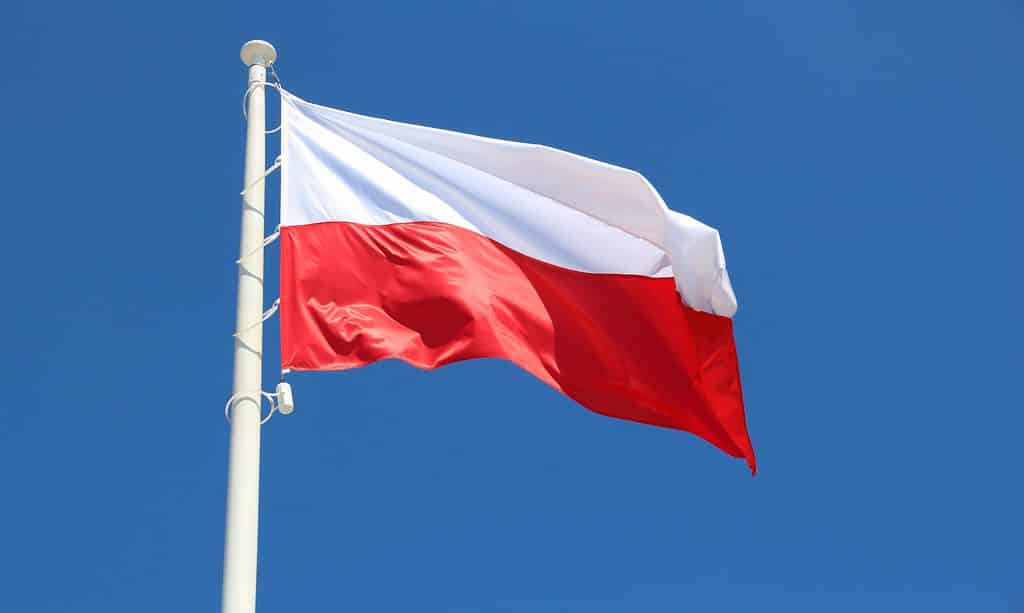
Poland borders Russia for 128 miles.
©iStock.com/tupungato
Russia and Poland share a border that extends for approximately 128 miles. The border is located in the northeastern part of Poland, as it shares a border with Belarus, which is situated between Poland and Russia.
The relationship between the two countries has been complex and influenced by historical conflicts and territorial disputes. Political differences and security concerns have also contributed to occasional strains in their relationship.
7. Belarus

Russia and Belarus have historically maintained close ties.
©M_Videous/Shutterstock.com
The Russia-Belarus border spans over 807 miles. The border is located in the northern part of Belarus. It runs through rural areas and may include border crossing points. The border between Belarus and Russia has been a subject of historical and political significance, including issues related to territorial disputes and security concerns.
Russia and Belarus have historically maintained close ties, with shared cultural, economic, and political interests. However, disputes over energy prices, political alignment, and sovereignty have occasionally strained their relationship.
8. Ukraine
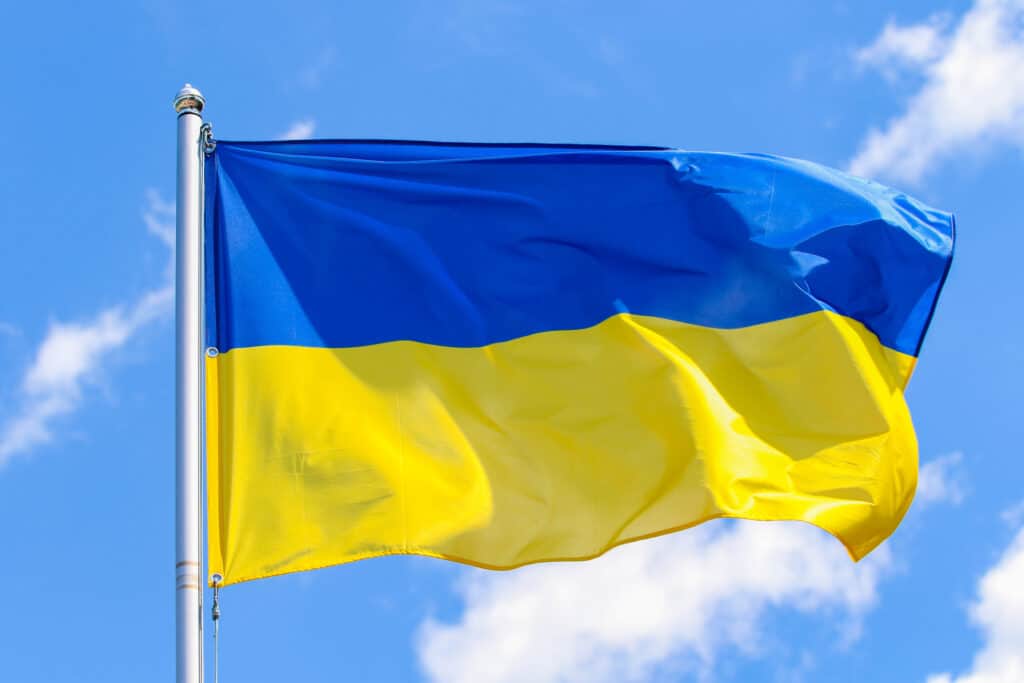
Ukraine’s relationship with Russia has been influenced by historical, linguistic, and cultural factors.
©iStock.com/olegda88
The Ukraine-Russia border is approximately 1,426 miles long. The border runs along the eastern part of Ukraine, including regions such as Donetsk and Luhansk.
The relationship between the two countries has been highly complex and influenced by historical, linguistic, and cultural factors. Conflicts, such as the annexation of Crimea and the ongoing conflict in eastern Ukraine, have significantly strained their relationship.
9. Georgia

Mountain Mkinvartsveri is in Georgia’s Kazbegi National Park.
©Le one/Shutterstock.com
The Russia-Georgia border is around 555 miles long. The border runs along the northern and northeastern parts of Georgia, including regions such as South Ossetia and Abkhazia.
The relationship between the two countries has been tense, marked by the 2008 Russo-Georgian War and subsequent territorial disputes. These conflicts have strained diplomatic relations and hindered cooperation in various areas.
10. Azerbaijan:
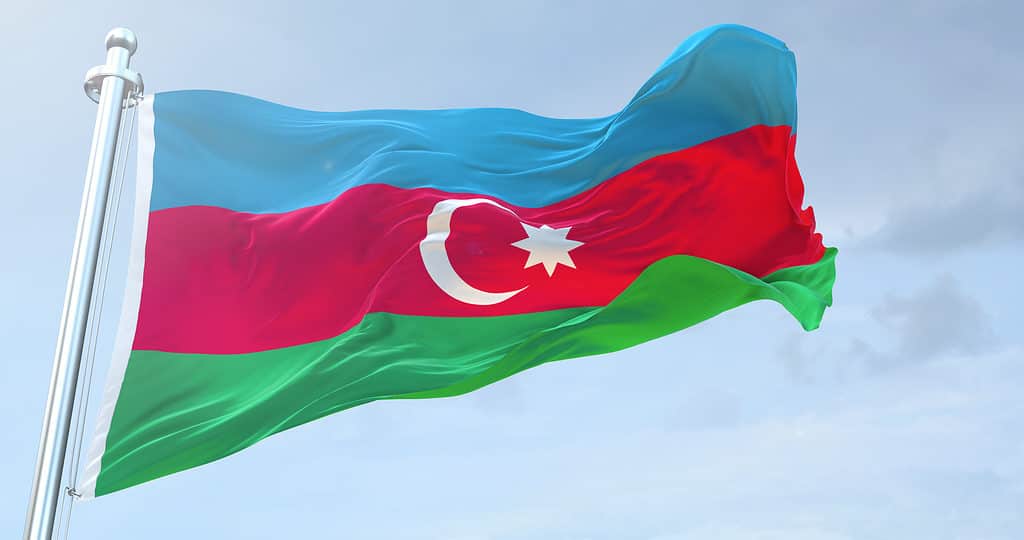
The flag of Azerbaijan is a traditional tricolor.
©iStock.com/EA
Russia and Azerbaijan share a border that extends for approximately 242 miles. The border between Azerbaijan and Russia is located in the northern part of Azerbaijan. It runs along the northern regions of Azerbaijan, including areas such as Dagestan.
The relationship between the two countries has been characterized by economic cooperation, particularly in the energy sector. However, territorial disputes, such as the Nagorno-Karabakh conflict, have occasionally strained their relationship.
11. Kazakhstan
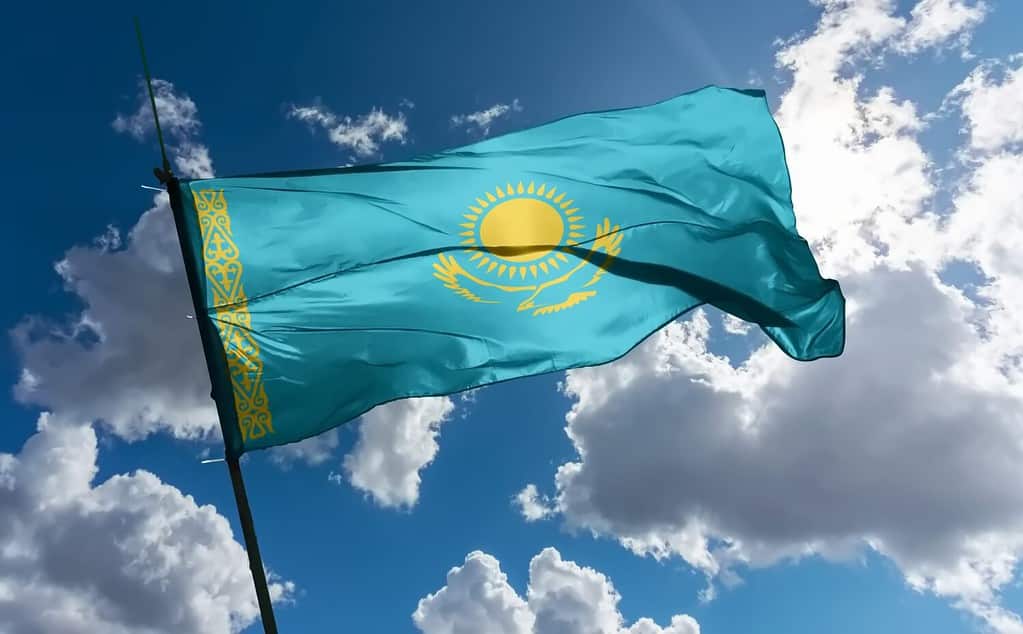
Despite occasional disagreements, Kazakhstan and Russia maintain strong ties.
©Svet foto/Shutterstock.com
The Russia-Kazakhstan border spans over 4,660 miles. The border is located in the northern part of Kazakhstan. It runs along the northern regions of Kazakhstan, including areas such as West Siberia.
The relationship between the two countries is multifaceted, with close economic ties and shared cultural heritage. Despite occasional disagreements, Kazakhstan and Russia maintain strong diplomatic and strategic cooperation.
12. Mongolia

Mongolia is a landlocked country in eastern Asia, which is bordered by Russia and China.
©Johnstocker Prodution/Shutterstock.com
Russia and Mongolia share a border that stretches for approximately 2,165 miles. The border between Mongolia and Russia is located in the northern part of Mongolia. It runs along the northern regions of Mongolia, including areas such as the Mongolian Altai Mountains and the Gobi Altai Mountains.
The relationship between the two countries has been historically significant, with deep cultural and economic ties. Cooperation in areas such as trade, energy, and transportation has strengthened their relationship.
13. China
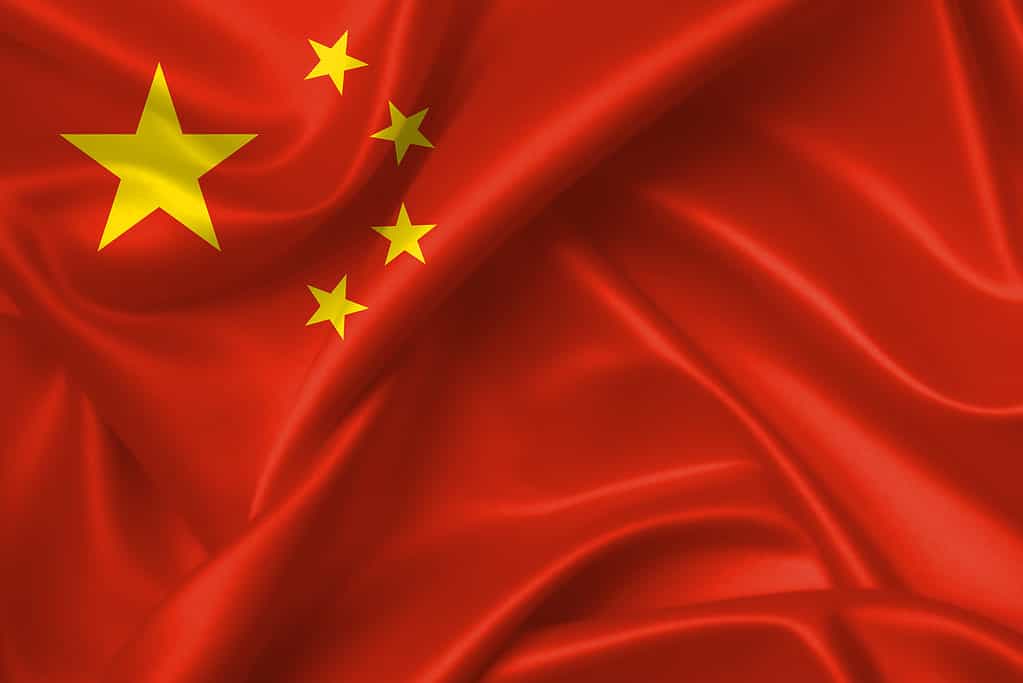
The relationship of Russia and China has transitioned from historical tensions to a strategic partnership.
©iStock.com/Anchiy
The Russia-China border extends for approximately 2,615 miles. The border between China and Russia is located in the northern part of China. It runs along the northern regions of China, including areas such as Xinjiang and Inner Mongolia. The China-Russia border is one of the longest international borders in the world.
The relationship between the two countries has evolved from historical tensions to a strategic partnership, with extensive economic cooperation and diplomatic dialogue. However, territorial disputes and competition for regional influence continue to be areas of potential friction.
14. North Korea
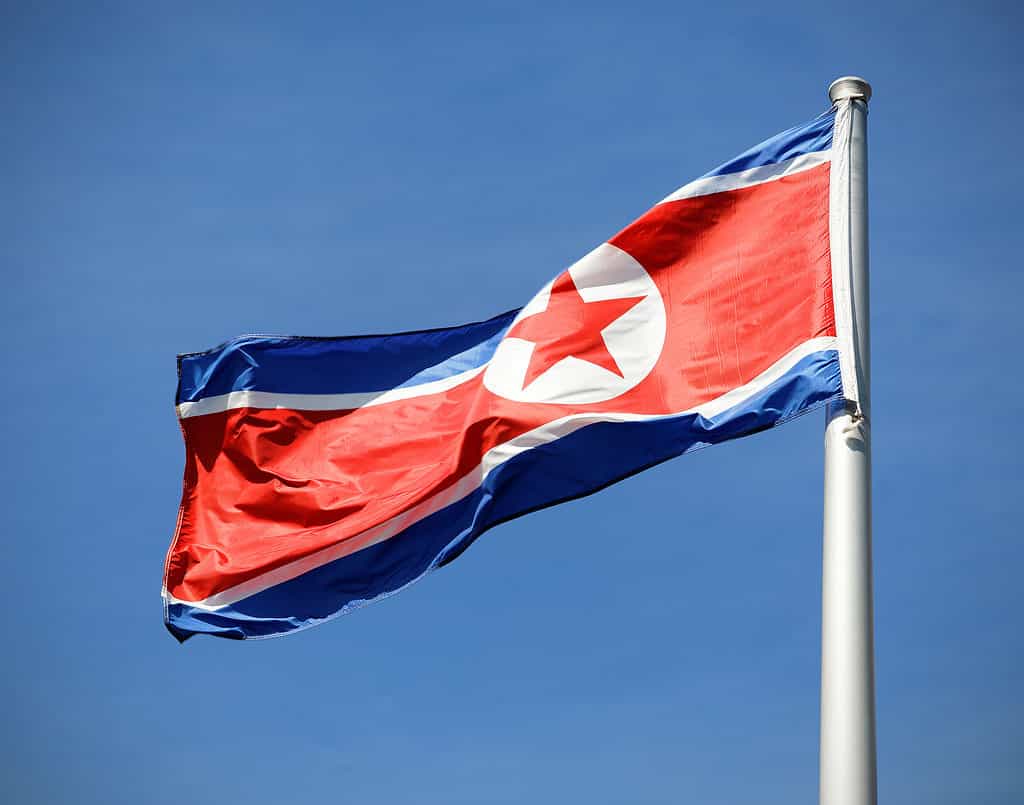
North Korean borders Russia for only 10 miles.
©Katherine Welles/Shutterstock.com
The Russia-North Korea border is relatively short, spanning around 10 miles. It is located in the northern part of North Korea. It runs along the northern regions of North Korea, potentially including areas such as the Tumen River.
The relationship between the two countries has historical and political significance. Russia has been involved in diplomatic efforts to address the security concerns and nuclear proliferation issues on the Korean Peninsula.
In Conclusion
After our exploration of the 14 countries that border Russia, it becomes evident that the geopolitical landscape surrounding Russia’s borders is a complex tapestry of relationships. From historic alliances and cultural ties to territorial disputes and political tensions, each country’s history plays a significant role in shaping Russia’s foreign policy and regional dynamics.
Over time, these bordering countries have experienced a range of interactions with Russia, marked by cooperation, conflicts, and strategic rivalries. While some relationships have been characterized by close economic ties and cultural exchanges, others have been strained by land disputes and geopolitical competition.
Looking ahead, the relationships between Russia and its bordering countries will continue to evolve in response to changing geopolitical dynamics and global challenges. It is essential for all parties involved to seek avenues of dialogue, cooperation, and mutual understanding to foster peace, stability, and prosperity in the region.
The photo featured at the top of this post is © dikobraziy/ via Getty Images
Thank you for reading! Have some feedback for us? Contact the AZ Animals editorial team.







